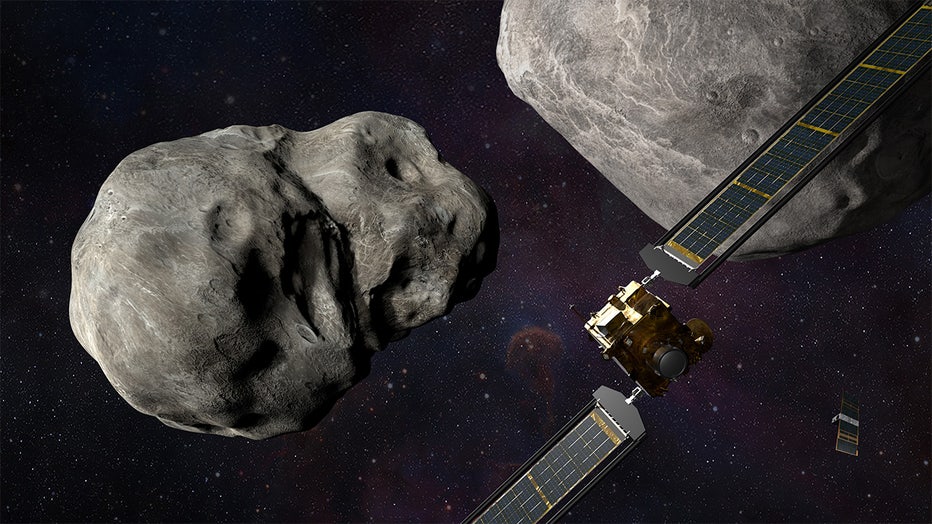Direct impact: NASA's DART spacecraft successfully slams into asteroid
NASA's DART spacecraft slams into target asteroid in defense test
The galactic slam occurred at a harmless asteroid 7 million miles (9.6 million kilometers) away, with the spacecraft named DART plowing into the space rock at 14,000 mph (22,500 kph). Scientists expected the impact to carve out a crater, hurl streams of rocks and dirt into space and, most importantly, alter the asteroid’s orbit.
CAPE CANAVERAL, Fla. - NASA's DART spacecraft appeared to successfully make direct impact with a small asteroid on Monday evening in an effort to divert it. The event was streamed live.
"We have impact!" Mission Control's Elena Adams announced, jumping up and down and thrusting her arms skyward.
Though the impact was immediately obvious — DART’s radio signal abruptly ceased — it will be days or even weeks to determine how much the asteroid’s path was changed.
The DART mission, which stands for NASA’s Double Asteroid Redirection Test, is key to the space agency’s goal of developing technology that could one day prevent a killer asteroid from striking Earth.
"This is stuff of science-fiction books and really corny episodes of ‘Star Trek’ from when I was a kid, and now it’s real," NASA program scientist Tom Statler said last week.
"We’re embarking on a new era of humankind," said NASA's Lori Glaze, planetary science division director.

This illustration is of the DART spacecraft and the Italian Space Agency’s (ASI) LICIACube prior to impact at the Didymos binary system. (NASA/Johns Hopkins, APL/Steve Gribben)
Here’s what you need to know about the collision:
What is the DART mission, exactly?
The DART mission is humanity's first-ever attempt to change the motion of an asteroid in space by intentionally crashing a spacecraft into it.
The $325 million planetary defense test began with DART’s launch last fall.
The target is the asteroid Didymos and its secondary body — or "moonlet" — known as Dimorphos. While the Didymos primary body is about a half-mile across, Dimorphos is about 520 feet in size, "which is more typical of the size of asteroids that could pose the most likely significant threat to Earth," the space agency states on its website.
NASA says the two asteroids are not a threat to Earth, but because they do pass close to the planet, Didymos and its small moonlet were chosen for the mission.
On Monday evening, DART was set to slam Dimorphos head-on at 14,000 mph. The impact should be just enough to nudge the asteroid into a slightly tighter orbit around its companion space rock — demonstrating that if a killer asteroid ever heads our way, we’d stand a fighting chance of diverting it.
The size of a small vending machine at 1,260 pounds, the spacecraft will slam into roughly 11 billion pounds of asteroid.
NASA's Operation DART: Engineer speaks about Monday's asteroid test
Lisa Wu, DART deputy engineer, speaks with FOX 9's Tim Blotz about NASA's operation, in which it will slam a spacecraft into an asteroid. The hope is that what NASA will learn from Monday's mission will one day save Earth from a catastrophic impact. DART stands for Double Asteroid Redirection Test.
"Sometimes we describe it as running a golf cart into a Great Pyramid," said Nancy Chabot, a planetary scientist and mission team leader at Johns Hopkins University’s Applied Physics Laboratory, which is helping to manage the effort.
RELATED: Images from asteroid-smashing DART mission expected to be 'stunning'
This story was reported from Cincinnati. The Associated Press contributed.

